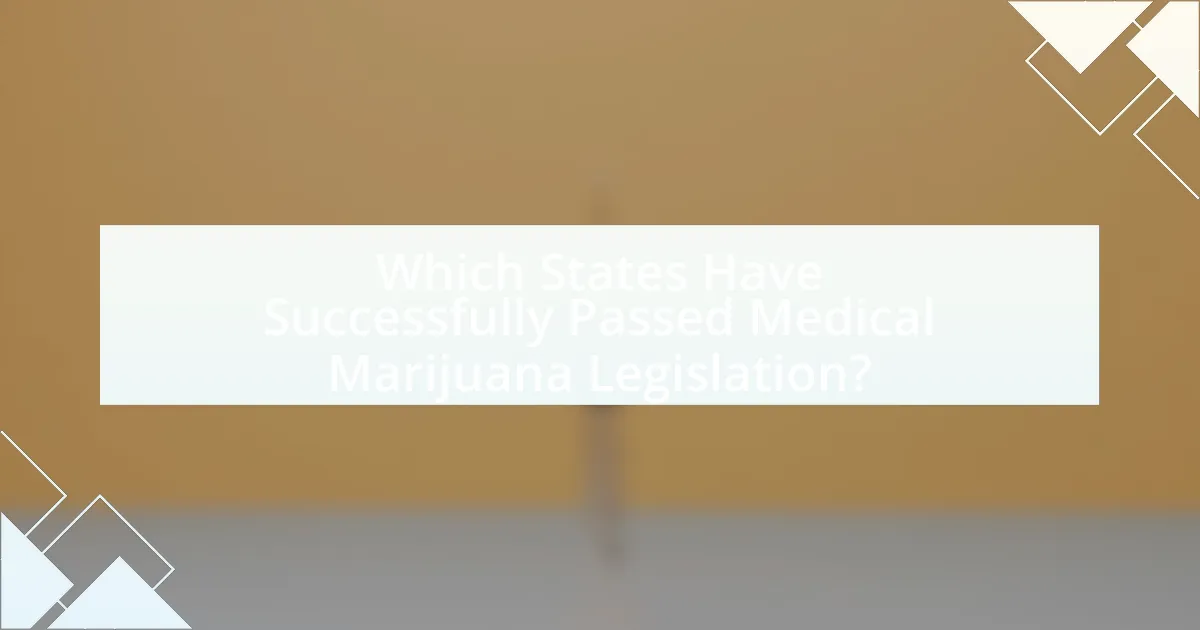The article examines successful legislative campaigns for medical marijuana across various states, highlighting key initiatives in California, Colorado, and Florida. It outlines the evolution of these campaigns from grassroots movements to organized political efforts, emphasizing the role of community engagement, advocacy groups, and strategic coalitions. Historical factors influencing public perceptions and legislative changes are discussed, along with the challenges faced by advocates, including opposition and regulatory hurdles. The article also details the economic and public health impacts of medical marijuana legislation, providing case studies that illustrate effective strategies and best practices for future advocacy efforts.

What are Successful Legislative Campaigns for Medical Marijuana?
Successful legislative campaigns for medical marijuana have included initiatives in states like California, Colorado, and Florida, where grassroots movements, strategic coalitions, and public education played pivotal roles. In California, the passage of Proposition 215 in 1996 marked the first state to legalize medical marijuana, driven by advocacy groups like the Cannabis Action Network and the support of patients who shared personal stories. Colorado’s Amendment 20 in 2000 succeeded due to a coalition of medical professionals and patient advocates who emphasized the therapeutic benefits of cannabis, leading to a robust regulatory framework. Florida’s Amendment 2 in 2016 gained traction through a well-funded campaign that highlighted the need for compassionate care, ultimately receiving over 71% of the vote. These campaigns demonstrate the effectiveness of mobilizing community support, leveraging personal narratives, and forming strategic alliances to achieve legislative success.
How have these campaigns evolved over time?
Medical marijuana legislative campaigns have evolved significantly over time, transitioning from grassroots movements to organized political efforts. Initially, these campaigns focused on raising awareness about the medical benefits of cannabis, often relying on personal stories and local activism to garner support. Over the years, as public opinion shifted in favor of legalization, campaigns became more structured, utilizing data-driven strategies and professional lobbying to influence lawmakers. For instance, the successful passage of California’s Proposition 215 in 1996 marked a pivotal moment, setting a precedent that inspired similar initiatives across other states. By 2020, 36 states had legalized medical marijuana, reflecting a broader acceptance and a more sophisticated approach to advocacy, including coalition-building with healthcare professionals and leveraging social media for outreach.
What historical factors influenced the push for medical marijuana legislation?
The push for medical marijuana legislation has been influenced by several historical factors, including changing public perceptions, medical research, and social movements. In the late 20th century, the counterculture movement of the 1960s and 1970s began to challenge the stigma surrounding marijuana, leading to increased advocacy for its medicinal use. Additionally, studies in the 1970s and 1980s, such as those conducted by the National Academy of Sciences, highlighted potential therapeutic benefits of cannabis for conditions like chronic pain and nausea from chemotherapy. The establishment of organizations like the National Organization for the Reform of Marijuana Laws (NORML) further galvanized public support and legislative efforts. These factors collectively contributed to a growing recognition of medical marijuana’s potential, ultimately influencing state-level legislative changes in the 1990s and beyond.
How have public perceptions changed regarding medical marijuana?
Public perceptions regarding medical marijuana have shifted significantly towards acceptance over the past two decades. Initially viewed with skepticism, a growing body of research highlighting the therapeutic benefits of cannabis has contributed to increased public support. For instance, a 2021 Gallup poll indicated that 68% of Americans favor legalizing marijuana for medical use, a notable increase from just 34% in 2001. This change is further evidenced by the successful passage of medical marijuana legislation in numerous states, reflecting a broader societal recognition of its potential health benefits and a move away from stigmatization.
What key strategies are employed in these campaigns?
Key strategies employed in successful legislative campaigns for medical marijuana include grassroots mobilization, coalition building, targeted messaging, and leveraging data-driven research. Grassroots mobilization involves engaging local communities to advocate for policy changes, which has proven effective in states like California, where extensive volunteer networks helped gather signatures for ballot initiatives. Coalition building brings together diverse stakeholders, such as patient advocacy groups, healthcare professionals, and legal experts, to create a unified front, as seen in Florida’s campaign that united various organizations to support medical marijuana legislation. Targeted messaging focuses on addressing specific concerns of lawmakers and the public, utilizing personal stories and testimonials to humanize the issue, which was a critical element in the successful campaigns in Colorado. Finally, leveraging data-driven research provides empirical evidence to support claims about the benefits of medical marijuana, influencing public opinion and legislative decisions, as demonstrated by studies cited in campaigns in states like New York.
How do grassroots movements contribute to legislative success?
Grassroots movements significantly contribute to legislative success by mobilizing community support and influencing public opinion. For instance, in the case of medical marijuana legalization, grassroots organizations like the Marijuana Policy Project have effectively organized campaigns that educate the public and lawmakers about the benefits of medical cannabis. These movements often utilize petitions, rallies, and social media to raise awareness and demonstrate widespread support, which can sway legislators to act favorably on proposed bills. A notable example is California’s Proposition 215, which was passed in 1996 largely due to grassroots efforts that highlighted patient needs and garnered extensive community backing. This illustrates how grassroots movements can create a compelling narrative that legislators cannot ignore, ultimately leading to successful legislative outcomes.
What role do advocacy groups play in shaping policy?
Advocacy groups play a crucial role in shaping policy by mobilizing public support, influencing lawmakers, and providing expert information on issues. These organizations often engage in grassroots campaigns, lobbying efforts, and public education to raise awareness about specific policies, such as medical marijuana legislation. For instance, in states like California and Colorado, advocacy groups successfully campaigned for the legalization of medical marijuana by presenting research on its benefits and organizing voter initiatives, which led to significant legislative changes. Their efforts demonstrate how advocacy groups can effectively impact policy decisions through strategic communication and community engagement.
What challenges do these campaigns face?
These campaigns face significant challenges including opposition from political groups, regulatory hurdles, and public misconceptions about medical marijuana. Political groups often lobby against legalization efforts, citing concerns over public health and safety, which can hinder legislative progress. Regulatory hurdles arise from the need to navigate complex legal frameworks at both state and federal levels, complicating the implementation of medical marijuana programs. Additionally, public misconceptions about the efficacy and safety of medical marijuana can lead to resistance from constituents, making it difficult to garner widespread support for legislative initiatives. These factors collectively impede the success of campaigns aimed at legalizing medical marijuana.
How do legal and regulatory hurdles impact campaign efforts?
Legal and regulatory hurdles significantly impede campaign efforts by creating barriers to entry and compliance for advocates. For instance, in states where medical marijuana legislation was pursued, campaigns often faced stringent regulations regarding advertising, fundraising, and lobbying activities, which limited their ability to effectively mobilize support. A notable example is California’s Proposition 215 campaign in 1996, where legal challenges and regulatory scrutiny delayed implementation and required extensive legal resources, ultimately affecting the campaign’s momentum and outreach efforts. These hurdles can lead to increased costs and resource allocation towards legal compliance rather than direct advocacy, thereby diminishing the overall effectiveness of campaign strategies.
What opposition do advocates encounter during campaigns?
Advocates encounter significant opposition during campaigns for medical marijuana legislation, primarily from political groups, law enforcement agencies, and public health organizations. Political groups often oppose legalization due to ideological beliefs or concerns about potential societal impacts, while law enforcement agencies may argue that legalization could complicate drug enforcement efforts. Public health organizations sometimes express concerns regarding the health implications of marijuana use, citing studies that highlight risks associated with its consumption. For instance, a 2019 study published in the Journal of Drug Policy Analysis indicated that opposition from these entities can significantly influence public perception and legislative outcomes, demonstrating the multifaceted challenges advocates face in their campaigns.

Which States Have Successfully Passed Medical Marijuana Legislation?
As of October 2023, 38 states and the District of Columbia have successfully passed medical marijuana legislation. These states include California, Colorado, Florida, Illinois, New York, and Texas, among others. The legalization efforts in these states have been driven by various factors, including public support for medical cannabis, advocacy from patient groups, and research highlighting the therapeutic benefits of marijuana for conditions such as chronic pain, epilepsy, and cancer. The successful passage of these laws often involved comprehensive legislative campaigns that included public education, lobbying, and coalition-building among stakeholders.
What are the notable case studies of successful campaigns?
Notable case studies of successful campaigns for medical marijuana legislation include California’s Proposition 215 in 1996, which was the first state initiative to legalize medical marijuana, setting a precedent for other states. Another significant case is Colorado’s Amendment 20 in 2000, which established a regulated medical marijuana program and demonstrated the viability of such legislation. Additionally, Florida’s Amendment 2 in 2016 successfully passed with 71.3% of the vote, showcasing strong public support for medical marijuana access. These campaigns effectively utilized grassroots mobilization, public education, and coalition-building strategies, leading to significant legislative changes across various states.
How did California’s campaign set a precedent for other states?
California’s campaign for medical marijuana, which culminated in the passage of Proposition 215 in 1996, set a precedent for other states by being the first to legalize medical cannabis through voter initiative. This landmark legislation demonstrated a successful model for grassroots advocacy and public support, influencing subsequent states to pursue similar measures. Following California’s lead, over 30 states have enacted their own medical marijuana laws, often citing California’s framework as a foundational reference for their legislative efforts.
What unique strategies were used in Florida’s medical marijuana campaign?
Florida’s medical marijuana campaign utilized unique strategies such as grassroots mobilization, targeted messaging, and coalition-building. Grassroots mobilization involved engaging local communities and leveraging social media to raise awareness and support for the initiative. Targeted messaging focused on the personal stories of patients who benefited from medical marijuana, which resonated emotionally with voters. Coalition-building included partnerships with various advocacy groups, healthcare professionals, and influential community leaders, which helped to amplify the campaign’s reach and credibility. These strategies contributed to the successful passage of the medical marijuana amendment in 2016, with approximately 71% of voters supporting the measure.
What lessons can be learned from these state-specific campaigns?
State-specific campaigns for medical marijuana demonstrate the importance of tailored messaging and grassroots mobilization. These campaigns effectively engage local communities by addressing specific needs and concerns, which fosters public support. For instance, in states like California and Colorado, campaigns highlighted personal stories of patients benefiting from medical marijuana, creating emotional connections that resonated with voters. Additionally, successful campaigns utilized data-driven strategies, such as polling and demographic analysis, to identify key voter segments and optimize outreach efforts. This approach not only increased voter turnout but also ensured that the messaging aligned with the values and priorities of the electorate.
How did community engagement influence outcomes in various states?
Community engagement significantly influenced outcomes in various states by mobilizing public support and shaping legislative agendas for medical marijuana initiatives. In states like California and Colorado, grassroots campaigns effectively organized community members, leading to increased voter turnout and advocacy that pressured lawmakers to consider medical marijuana legislation. For instance, in California, the 1996 Proposition 215 was propelled by extensive community outreach and education efforts, resulting in the first state to legalize medical marijuana. Similarly, in Colorado, community engagement through local advocacy groups played a crucial role in the successful passage of Amendment 20 in 2000, which established a medical marijuana program. These examples demonstrate that active participation and mobilization of community members can directly impact legislative outcomes and foster favorable policies regarding medical marijuana.
What role did political alliances play in legislative success?
Political alliances significantly enhanced legislative success in the context of medical marijuana campaigns by consolidating support across party lines and mobilizing resources. For instance, in states like California and Colorado, bipartisan coalitions formed between progressive and conservative lawmakers facilitated the passage of medical marijuana legislation, demonstrating that diverse political backing can overcome opposition. Additionally, these alliances often included advocacy groups and stakeholders, which provided crucial lobbying efforts and public support, further solidifying the legislative push. The successful passage of Proposition 215 in California in 1996, which was the first state law to legalize medical marijuana, exemplifies how strategic political alliances can lead to effective legislative outcomes.

What are the Impacts of Successful Medical Marijuana Legislation?
Successful medical marijuana legislation leads to improved patient access to therapeutic cannabis, resulting in enhanced quality of life for individuals with chronic pain, epilepsy, and other medical conditions. For instance, a study published in the Journal of Pain Research in 2019 found that patients using medical marijuana reported a 64% reduction in chronic pain symptoms. Additionally, successful legislation often generates significant tax revenue for states; Colorado, for example, collected over $1.5 billion in tax revenue from marijuana sales since legalization in 2014. Furthermore, such legislation can reduce the burden on the healthcare system by providing alternative treatment options, as evidenced by a 2018 study in Health Affairs that indicated states with medical marijuana laws saw a 25% decrease in opioid prescriptions.
How does medical marijuana legislation affect patients and healthcare?
Medical marijuana legislation significantly impacts patients and healthcare by increasing access to alternative treatment options for various medical conditions. This access allows patients suffering from chronic pain, epilepsy, multiple sclerosis, and other ailments to utilize cannabis as a therapeutic option, which has been shown to alleviate symptoms and improve quality of life. For instance, a study published in the Journal of Pain Research found that 94% of patients reported a reduction in pain after using medical marijuana. Furthermore, healthcare systems may experience changes in treatment protocols, as physicians become more educated about cannabis and its applications, leading to more comprehensive patient care.
What improvements in patient access have been observed post-legislation?
Post-legislation, significant improvements in patient access to medical marijuana have been observed, including increased availability of dispensaries and expanded eligibility criteria for patients. For instance, states like California and Colorado reported a rise in the number of licensed dispensaries, facilitating easier access for patients. Additionally, legislative changes often led to the inclusion of various medical conditions that qualify for treatment, broadening the patient base. In Colorado, the number of registered medical marijuana patients grew from approximately 40,000 in 2010 to over 100,000 by 2020, demonstrating enhanced access and acceptance.
How does medical marijuana legislation influence public health outcomes?
Medical marijuana legislation positively influences public health outcomes by increasing access to therapeutic options for patients with chronic pain, epilepsy, and other medical conditions. Research indicates that states with legalized medical marijuana report lower rates of opioid prescriptions and related overdose deaths, suggesting a potential reduction in opioid dependency. For instance, a study published in the Journal of the American Medical Association found that states with medical marijuana laws experienced a 25% reduction in opioid overdose mortality rates. Additionally, patients often report improved quality of life and symptom management when using medical marijuana, further supporting its role in enhancing public health.
What economic impacts arise from medical marijuana legislation?
Medical marijuana legislation generates significant economic impacts, including increased tax revenue, job creation, and reduced law enforcement costs. States that have legalized medical marijuana, such as Colorado and California, have reported millions in tax revenue; for instance, Colorado collected over $387 million in tax revenue from marijuana sales in 2020 alone. Additionally, the industry creates thousands of jobs in cultivation, distribution, and retail sectors, contributing to local economies. Furthermore, legalizing medical marijuana reduces law enforcement expenditures related to marijuana-related arrests and prosecutions, allowing funds to be redirected to other public services.
How does the legalization of medical marijuana affect state economies?
The legalization of medical marijuana positively affects state economies by generating significant tax revenue and creating jobs. For instance, states like Colorado have reported over $1 billion in tax revenue since legalizing medical marijuana in 2014, which has been allocated to education, healthcare, and infrastructure. Additionally, the industry has created thousands of jobs, with Colorado alone seeing over 30,000 jobs in the cannabis sector as of 2021. This economic boost is further supported by increased tourism and reduced law enforcement costs associated with marijuana-related offenses.
What job creation opportunities stem from the medical marijuana industry?
The medical marijuana industry creates numerous job opportunities across various sectors. These include positions in cultivation, where workers are needed for planting, growing, and harvesting cannabis plants; manufacturing, which involves processing raw cannabis into products like oils and edibles; and retail, where dispensaries require staff for sales, customer service, and inventory management. According to a report by Leafly, the cannabis industry supported over 300,000 jobs in the United States as of 2021, demonstrating significant employment potential. Additionally, ancillary services such as legal, accounting, and marketing also see increased demand due to the industry’s growth, further contributing to job creation.
What best practices can be derived from successful campaigns?
Successful campaigns for medical marijuana legislation demonstrate several best practices, including building broad coalitions, utilizing data-driven messaging, and engaging in grassroots mobilization. Broad coalitions, such as alliances between patient advocacy groups, healthcare professionals, and legal experts, enhance credibility and reach. Data-driven messaging, supported by research showing the medical benefits of marijuana, effectively addresses public concerns and counters opposition. Grassroots mobilization, exemplified by community outreach and local events, fosters public support and encourages voter participation. These practices have been validated by successful campaigns in states like California and Colorado, where comprehensive strategies led to the passage of medical marijuana laws.
How can future campaigns leverage past successes for better outcomes?
Future campaigns can leverage past successes by analyzing effective strategies and tactics used in previous medical marijuana legislative campaigns. For instance, campaigns in states like California and Colorado successfully utilized grassroots mobilization and targeted messaging to engage voters, resulting in significant support for legalization measures. By studying these case studies, future campaigns can identify key demographics, messaging frameworks, and coalition-building techniques that resonated with the electorate. Additionally, data from these successful campaigns can inform resource allocation and timing, enhancing the overall effectiveness of outreach efforts.
What strategies should be prioritized for effective advocacy in new states?
Effective advocacy in new states should prioritize grassroots mobilization, coalition building, and targeted messaging. Grassroots mobilization engages local communities, ensuring that advocates can demonstrate widespread support for medical marijuana legislation, which is crucial for influencing policymakers. Coalition building with diverse stakeholders, including healthcare professionals, patients, and advocacy groups, enhances credibility and broadens the base of support, as seen in successful campaigns in states like California and Colorado. Targeted messaging that addresses specific concerns of legislators and the public, such as economic benefits and public health outcomes, has proven effective in swaying opinions and securing legislative victories. For instance, in 2012, Colorado’s campaign highlighted the potential tax revenue from legalized medical marijuana, which resonated with voters and legislators alike.

Leave a Reply